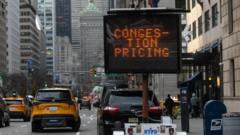New York City traffic patterns have shifted in favor of reduced congestion after the implementation of a congestion charge fee that began on January 5. The Metropolitan Transportation Authority (MTA) reports a significant decrease of 273,000 vehicles during weekdays within the central business district, representing a 7.5% decline compared to January’s average traffic estimates. This innovative fee structure charges up to $9 each day for passenger vehicles while imposing higher charges on larger vehicles, such as trucks and non-commuter buses.
The congestion zone encompasses a prime area of New York City, including major landmarks like the Empire State Building and Times Square. Janno Lieber, MTA's leader, has indicated that preliminary data supports the assertion that traffic is down, enhancing the overall safety of the streets and increasing the efficiency of bus services during rush hours. Residents and commuters alike are beginning to observe enhanced travel times for local and express buses, particularly in the morning commute, according to MTA updates shared on social media.
Despite the apparent success and local support for this initiative aimed at alleviating the city's longstanding traffic challenges and generating substantial funding for public transit, the program does face notable opposition. Critics include prominent figures like President-elect Donald Trump, who plans to dismantle the scheme upon taking office this month. Last year, New York City faced the unwanted distinction of being named the world's most congested urban area for the second consecutive year, according to traffic analysis by INRIX.
Overall, while early indicators show that the congestion charge is positively affecting traffic flow and public transport in New York City, the ongoing debate surrounding the policy highlights the complexities of urban transportation management and the varying perspectives within the community.





















